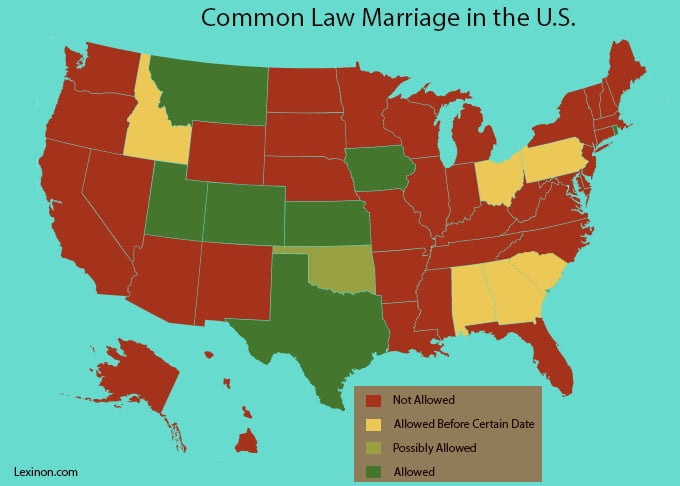Introduction to Common Law Marriage in Arizona
What Is Common-Law Marriage?
Common-law marriage is like a handshake agreement of being married, but without the big wedding or signing official papers. Imagine two people decide to live together, share their lives just like a married couple, and tell everyone they are married. In some places, after they do this for a while, the law might say, “Okay, you’re basically married,” even though they never had a wedding or got a marriage certificate. That’s common-law marriage. It’s like an unofficial marriage that some places accept as real, just based on the couple’s actions and how long they’ve been together.
Common Law Marriage Arizona
Talking about “common law marriage Arizona” is quite intriguing. Imagine a couple living together, just like they’re married, but without an official wedding or marriage certificate. In some places, the law might consider them married after a while, but Arizona doesn’t work like that.
In Arizona, you’re not married unless you follow the official steps – getting a marriage license and having a ceremony. Living together for years, sharing expenses, or even having kids together doesn’t make you legally married in Arizona. This is important because being married affects things like taxes, property ownership, and decision-making rights in serious situations. So, in Arizona, for all those married-couple benefits, you need to formally get married.
Fact #1: Recognition of Out-of-State Common Law Marriages
Here’s an interesting part about “common law marriage Arizona”. Suppose a couple had a common law marriage in Texas, where it’s recognized. They move to Arizona, which usually doesn’t recognize common law marriage. But in this case, Arizona respects their marriage status from Texas. It’s like how a driver’s license from one state is valid when you move to another.
So, if a couple is considered married under common law in another state, Arizona will acknowledge that. This is crucial for couples moving to Arizona, ensuring they don’t lose certain rights. They essentially bring their marital status from their previous state to Arizona.
Fact #2: No Legal Status for In-State Common Law Marriages

In Arizona, if you’re living with someone you love and acting like you’re married but haven’t had a wedding or signed marriage papers, it’s a different story. This situation is often called “common law marriage Arizona,” but here’s the catch: Arizona doesn’t give legal status to these relationships. That means even if you’ve been living together for many years, in the eyes of Arizona law, you’re not married.
For example, imagine a couple, Alex and Jordan, who have been living together in Arizona for 10 years. They share bills, have joint bank accounts, and everyone around them thinks of them as a married couple. However, since they never had a formal wedding or got a marriage license, Arizona law doesn’t see them as married. This can affect many things, like who inherits property if one of them passes away or who makes medical decisions in case of an emergency.
Fact #3: Palimony Rights in Arizona

Now, let’s talk about something called “palimony.” This is a bit like alimony, which is money one spouse might have to pay the other after a divorce. But palimony is for couples who were living together without being married. Although Common Law Marriage Arizona isn’t recognized, you might still have rights to palimony under certain conditions.
Let’s say Alex and Jordan, our couple from before, decide to part ways. They weren’t married, so there’s no divorce, but they might still have financial ties. If they had an agreement (maybe even just a spoken one) that one would support the other, the one who was supported might ask for palimony. This means they could receive financial support from their ex-partner, similar to how it works in a divorce.
It’s important to remember that palimony isn’t automatic. You’d need to prove there was an agreement for support. This makes it different from situations where a couple is legally married and gets divorced. In those cases, laws are more straightforward about who gets what. In Arizona, for unmarried couples, it’s more about what was agreed upon during their time together.
Fact #4: Cohabitation Agreements and Their Importance
In Arizona, where “common law marriage Arizona” isn’t legally recognized, there’s something called a cohabitation agreement that becomes super important. Think of it like a safety net for couples who live together but aren’t married. This agreement is a written document where the couple can outline how they’ll handle things like finances, property, and even pets if they ever decide to go their separate ways.
For example, let’s say Mia and Kai live together in Arizona. They’re not married, but they buy a house together and share a bank account. They decide to make a cohabitation agreement that says who gets what if they break up. This agreement is their way of making sure both of them are protected and know exactly what to expect.
Fact #5: Rights of Unmarried Couples in Arizona
Now, let’s talk about the rights of unmarried couples in Arizona. Since Arizona doesn’t recognize common law marriage, these couples don’t automatically get the same legal rights as married couples. This means they have to be a bit more proactive in protecting their rights.
For instance, if Mia and Kai, our cohabiting couple, decide to separate, they don’t have the same legal protections as a divorced married couple. They would need to rely on their cohabitation agreement or other legal documents they’ve set up to sort out their finances and property. It’s important for unmarried couples in Arizona to think about these things and maybe even get legal advice to make sure they’re covered.
Fact #6: The 10-Year Marriage Rule’s Impact
The 10-year marriage rule is another interesting aspect, especially when we talk about “common law marriage Arizona.” This rule is about spousal support (money one spouse pays to the other after a divorce) and it usually applies to married couples. In Arizona, if a couple was married for less than 10 years, the time they might receive or have to pay spousal support is often limited. But for marriages that lasted longer than 10 years, there’s more flexibility, and support might continue for a longer time.
This rule doesn’t directly apply to unmarried couples since they’re not recognized as married in Arizona. However, it’s a good example of how different the legal situation can be for married and unmarried couples. For unmarried couples like Mia and Kai, understanding these differences is crucial, especially when planning their future together.
Fact #7: Domestic Partnership Laws in Arizona
In Arizona, where “common law marriage Arizona” isn’t a thing, couples like Alex and Jordan have another option: domestic partnership. This is a way for couples who live together but aren’t married to get some legal recognition for their relationship. It’s not the same as being married, but it offers certain benefits.
For Alex and Jordan, registering as domestic partners means they can have some of the rights that married couples enjoy, like making important decisions for each other in emergencies or visiting each other in the hospital. It’s a way to officially acknowledge their relationship without getting married.
Domestic partnerships in Arizona are especially useful for couples who want to stay together and share their lives legally, but without the full commitment of marriage. It’s a middle ground, offering some security and recognition under the law.
Historical Perspective: When and Why Did Arizona Stop Recognizing Common Law Marriage?
Let’s take a step back in time to understand when and why Arizona decided to stop recognizing “common law marriage Arizona.” It’s a bit like looking through an old history book to find out why things changed.
Back in 1913, Arizona made a big decision. Before this year, if a couple lived together for a long time, acted like they were married, and told people they were married, they were considered legally married, even without a wedding or marriage license. This was what “common law marriage Arizona” used to be.
But why did Arizona change this in 1913? Well, the world was changing fast, and so were ideas about marriage and law. Arizona, just becoming a state in 1912, wanted to modernize its laws. The state decided that marriage needed to be a clear, legal agreement with specific steps, like a marriage license and a ceremony. This change was about making sure everything was clear and official. It was a move towards more structured and formal legal processes.
Think of it like this: In the old days, if you told someone you were married, that was often enough. But after 1913, Arizona said, “Hold on, we need more than just your word; we need an official record.” It’s like the difference between just telling someone you’re good at basketball versus actually showing them your skills in a game.
So, since 1913, living together and calling yourself married wasn’t enough in Arizona. Couples needed to follow the official steps to be legally recognized as married. This change was all about making sure that important things like marriage were clear and legally defined.
Conclusion
In conclusion, understanding “common law marriage Arizona” is crucial for couples in the state. Arizona does not recognize common law marriages formed within its borders, emphasizing the need for formal marriage procedures for legal recognition. Alternatives like domestic partnerships offer some legal benefits, but they differ from marriage. It’s important for couples to be aware of these distinctions and consider legal agreements to protect their rights. This knowledge ensures that couples in Arizona can make informed decisions about their relationships and legal standings.

Top 13 FAQs About Common-Law Marriage Arizona
Does Arizona have domestic partnership?
Yes, some cities in Arizona offer domestic partnership registries. However, these partnerships may not provide the same state-wide legal benefits as marriage.
What states do not recognize common law marriage?
Many states, including Arizona, do not recognize common law marriage. Other states like California, New York, and Florida also do not recognize it.
What is considered a long-term marriage in Arizona?
In Arizona, a long-term marriage typically refers to marriages that last for 20 years or more.
What is it called when you live with someone but not married?
This arrangement is commonly known as cohabitation.
What is it called when you live with someone for 7 years but not married?
Living together for 7 years without being married is still referred to as cohabitation. It does not constitute a “common law marriage Arizona.”
Is Arizona a common law wife state?
No, Arizona does not recognize “common law marriage Arizona” or common law wife status.
Is Arizona a palimony state?
Arizona does not have specific palimony laws, but courts may consider agreements between unmarried couples for support.
Does Arizona have cohabitation laws?
Arizona doesn’t have specific cohabitation laws, but cohabiting couples can have legal agreements like cohabitation agreements for their protection.
What are the marriage laws in Arizona?
Arizona requires a legal marriage license and a ceremony for marriage. “Common law marriage Arizona” is not recognized.
What happens if my partner dies and we are not married?
If your partner dies and you’re not married, you won’t have the same rights as a spouse. It’s important to have legal documents like wills for protection.
How long before a relationship is considered common law marriage?
In states that recognize common law marriage, the time varies. However, in Arizona, no duration of a relationship results in a “common law marriage Arizona.”
How do I file for domestic partnership in Arizona?
Filing for a domestic partnership in Arizona, where “common law marriage Arizona” isn’t recognized, involves a few steps:
Check City Rules: First, see if your city in Arizona offers domestic partnership registration by contacting the city clerk’s office or checking their website.
Gather Documents: Collect necessary documents that prove your committed relationship, like IDs and joint bills or bank statements.
Fill Out the Application: Complete the application form provided by your city to officially declare your partnership.
Pay the Fee: Pay the registration fee, which varies by city.
Submit the Application: Hand in your application either online or in person at the city clerk’s office.
Wait for Approval: The city will review your application and, if all is correct, register your domestic partnership.
This process provides some legal recognition for couples, offering benefits like making medical decisions for each other, a valuable option in Arizona.
Common Law Marriage in Other States
- Common Law Marriage California
- California does not recognize common law marriage. No matter how long a couple lives together or represents themselves as married, they are not considered legally married without a formal marriage license and ceremony.
- Common Law Marriage Texas
- Texas recognizes common law marriage, also known as an “informal marriage.” For a common law marriage to be valid in Texas, the couple must agree to be married, live together in Texas as a married couple, and represent to others that they are married.
- Montana Common Law Marriage
- Montana is one of the few states that recognize common law marriage. Couples in Montana can be considered legally married without a ceremony or marriage license if they live together, have the capacity to marry, and present themselves as a married couple to others.
- Common Law Marriage New Mexico
- New Mexico does not recognize common law marriages. Similar to “common law marriage Arizona,” couples living together in New Mexico are not considered legally married regardless of the duration of their cohabitation.
In each of these states, the recognition of common law marriage varies, reflecting different legal perspectives on relationships and cohabitation. While some states like Texas and Montana recognize these unions under certain conditions, others like California and New Mexico, similar to Arizona, do not recognize “common law marriage Arizona” or in their respective states.
Resources on Common Law Marriage Arizona

For those interested in learning more about “common law marriage Arizona” and related topics, here are some reliable and authentic resources with active hyperlinks:
- Arizona Revised Statutes: For comprehensive legal details on marriage laws in Arizona, including aspects related to “common law marriage Arizona,” visit the Arizona State Legislature’s website.
- City Clerk’s Offices in Arizona: To understand the specifics of domestic partnership registration in various Arizona cities, check the websites of city clerk’s offices. For example, the Phoenix City Clerk’s Office provides information relevant to residents of Phoenix.
- National Conference of State Legislatures (NCSL): For a broader understanding of how “common law marriage Arizona” compares to other states, the NCSL offers a detailed overview of common law marriage by state. Visit their page on Common Law Marriage by State.
- Legal Aid Services in Arizona: For legal assistance or advice, especially if you’re considering options similar to “common law marriage Arizona,” organizations like Community Legal Services can be helpful.
- Arizona Family Law Attorneys: For personalized legal advice, especially regarding matters similar to “common law marriage Arizona,” consulting with a family law attorney in Arizona is advisable. The State Bar of Arizona offers resources to find qualified attorneys.
These resources provide a starting point for anyone seeking detailed and accurate information about “common law marriage Arizona” and related legal matters in Arizona.
Read More at Yankeeinsightful.com : The 7 Remarkable Stages in the Evolution of French Manicure: From Red Crescent to Modern Elegance

